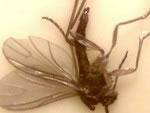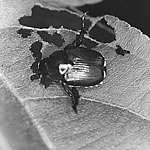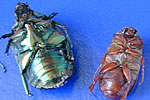Some Background

Roughly ninety percent of all insects spend at least some portion of their lives in the confines of the dirt kingdom. This number is inclusive of good bugs, bad bugs and those in between. There are basically three types of insects, at least as it applies in this text, which can be found down-under: good bugs, which we will not concern ourselves with on this web page; bad bugs, which are bad because they cause damage to plant roots, bulbs etc.; and bad bugs which do not cause damage to roots and the such, but are merely developing in the soil so they can once again rise and become above-ground phytophagous or plant-eating pests.
A Variety of Pests

These pests, regardless of which category they fall into, are members of several insect orders: Coleoptera, which are beetles; Lepidoptera, which are moths and butterflies; Diptera, which are flies; and others of equal importance. We’re talking about thousands of insects — wow! This all equates to one very important fact: the soil is a good place to practice pest control. Time of year will be one of the only variables you’ll be concerned with as not all the pests you may wish to target will likely be in the dirt kingdom at the same moment. Some pests spend time in the soil several times during every season. Some are always present, while others visit only once a year.
Leafminers

As mentioned in the page, Leafminer Pests, those critters which are members of two orders, Lepidoptera and Diptera, can be pests which aren’t considered pests in the soil. Again, leafminers, as larvae, when they are through tunneling through your leaves, drop to the ground to pupate — at least the Dipteran leafminers do. Timing isn’t too critical when it concerns these pests as there are likely to be pupae present at any given time in greenhouses, but more seasonally outdoors. If you see the mines beginning to develop, an immediate implementation of leafminer parasitoids would be appropriate, followed soon after with an appropriate soil-pest biocontrol.
Cutworms

Cutworms, one of the pests mentioned in Caterpillar Pests, are extremely vulnerable in the soil. And this is good as this is when and where they exhibit their undesirable behavior — they are soil pests. Cutworms stay in the root-zone of target plants during daylight hours and are of little concern to growers. At night they are of great concern — especially to gardeners and farmers (they are not really a greenhouse pest in most cases). They come to the soil’s surface and wrap their bodies around the stems of newly emerged plants. There they feed on the plant’s stem, often severing it. At sunup they go back down to the safety of the dirt kingdom. When the gardener heads back out to garden he or she will notice a plant, or plants, laying over with its stem chewed and nearly cut off at, or very near, ground level. The plant will be doomed unless it can send up new shoots. Targeting cutworms under most circumstances requires a preemptive action, before the plants are lost. With some crops the gardener or farmer gets a second chance.
Beetle Grubs

Not previously mentioned on this web site are Japanese beetles, pests with which gardeners, orchardist and nurserymen are all too familiar. Japanese beetles, members of Coleoptera, devour the leaves of many popular plants, shrubs and trees. Common hosts include bush beans, roses and flowering crab trees, for starters. Moreover, they not only have their larval stage in the soil, they’ve been known to deaden patches of lawn if their “grub” numbers are significant. This makes Japanese beetles unique sort of pests, being in their glory above and below ground. Non-chemical means of controlling the adults once they’re seen on the foliage is difficult and time-consuming at best. The larvae or grubs are a different matter. There are generally two times to target the grubs: spring and late summer into fall — as that’s when they’re in their larval stage and residing in the soil.
Fungus Gnats and Flies

One important pest — or category of pests — very common to greenhouses and other indoor areas, and the main focus of this chapter, would be fungus gnats, or mushroom flies as they’re called in that industry. This is especially true where artificial, sphagnum peat-based, manure-rich or compost-laden growing media are being used. These pests are generally from three genera (a taxonomical grouping) belonging to the order Diptera: Lycoriella, Sciara, and Bradysia spp. It is now common knowledge that fungus gnats can actually be quite devastating to crops. They are known to feed on root hairs — which are essential to a plant’s uptake of nutrients — they vector root rot — causing bacteria and viruses and other soil borne diseases, and can actually kill plants outright if not kept in check.
And More

Other pests which can be fairly easily controlled underground, but more difficult to deal with above ground include the following: Black vine, carrot and strawberry-root weevils; sod webworms, wire- and potato-tuber worms; apple, carrot-rust fly, onion and cabbage maggots; and flea, June/May and cucumber beetle larvae. There are many species of pests which can be dealt with more easily when in their vulnerable subterranean stages, way too many to list here. Why, even fleas can be dealt with, and filth-breeding flies, and…? Well, you get the point.
Serious Pests

Fungus gnats are easy to detect — by using yellow sticky traps and potato disks — and their control is pretty straightforward. If you let them get out of hand, though, they can be a serious problem. Fungus gnats can be a problem with nearly any plant, large or small. Needless to say, the smaller or younger the plants, the more quickly they fall and the more vulnerable they are. Fortunately, since many plants sown by seed are planted in a fine milled sphagnum mix, which tends to be freer of viable fungus gnat eggs, the plants can usually be problem free until they are re-potted into a coarser mix-unless their nursery is in a structure where surrounding plants may already be affected.
 The eggs hatch, the larvae feed and pupate in the media, and the adults subsequently come forth — a complete metamorphosis. The adults mate, land on the soil and lay more eggs to repeat the cycle. If there is rotting debris on the medium’s surface, or algae from top-watering a nitrogen-based fertilizer solution, they will have a preference to those plants. If those problems can be better dealt with, you’ll reduce your fungus gnat problem. Algae is directly attributed to many chemical fertilizers being so nitrogen-rich, and is not easily avoided unless you use another methods of fertilization or alter the way it is applied, i.e., use a bottom-irrigated method in lieu of top-watering. The amount of water being used can also contribute to the problem. If the plants will do well if their substrate is allowed to dry between waterings, let them. This will hamper the activity of fungus gnats. Regarding debris on the medium’s surface, clean it up. Run a tight ship.
The eggs hatch, the larvae feed and pupate in the media, and the adults subsequently come forth — a complete metamorphosis. The adults mate, land on the soil and lay more eggs to repeat the cycle. If there is rotting debris on the medium’s surface, or algae from top-watering a nitrogen-based fertilizer solution, they will have a preference to those plants. If those problems can be better dealt with, you’ll reduce your fungus gnat problem. Algae is directly attributed to many chemical fertilizers being so nitrogen-rich, and is not easily avoided unless you use another methods of fertilization or alter the way it is applied, i.e., use a bottom-irrigated method in lieu of top-watering. The amount of water being used can also contribute to the problem. If the plants will do well if their substrate is allowed to dry between waterings, let them. This will hamper the activity of fungus gnats. Regarding debris on the medium’s surface, clean it up. Run a tight ship.
Some Advice

Shore flies, which are larger and fuller-bodied than fungus gnats, are attracted to algae, and can be seen on pots, but their larvae are strictly algae-eaters, so if you can tolerate their presence they will be nonthreatening. Like mom said: “Leave them alone, and they’ll leave you alone.” However, if you’re in a retail environment, you may have to deal with your customers’ objections — it can be bad business — so you’ll have to cure the algae problem and dry areas of standing water. Oh, and hang lots of yellow sticky traps. Humpbacked flies and moth flies, or drain flies as they’re sometimes called, though not real pests in the plant-destructive sense of the word, can be a bad thing to have flying around. They can be reduced if algae, standing water and its associated algae, and rotting plant debris is removed, and sticky traps employed to reduce adult numbers.
For the Scout

Fungus gnats are four to five millimeters in size, delicate and mosquito-like, and have a distinctive Y-shaped vein on their wings (the top, open end of the “Y” is towards the wing-tip). They readily get themselves stuck on yellow sticky traps. The traps can be useful in reducing adult numbers in addition to their usefulness as scouting aids. Yellow traps will be most effective if laid sticky side up on the medium’s surface; just peel back one side at a time. Do expect the traps to become littered with debris from watering and other common activities, though, what with being so close to the action. The debris may also make bug-counting more difficult. Potato disks, which have been previously mentioned, are very useful in detecting the gnats’ larvae, isolating problem containers, and at reducing larval numbers — assuming you frequently change the quarter-inch disks. Moreover, potato disks are useful in playing a part of a control program and for population monitoring where sticky traps would be impractical, such as in many interiorscapes.
Some Solutions
There are few biological pest control agents available to address the multitude of soil pests which lurk in our growing areas. Fortunately, though, the ones which are available are fairly cost-effective, readily available and are very good at what they do. One control, in particular, entomogenous or parasitic nematodes, control a huge number of soil pests, including all of the pests discussed on this page (they can even control some above-ground, boring and similar pests if applied appropriately).
